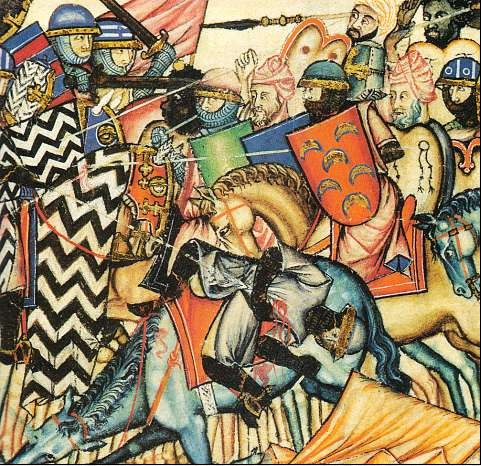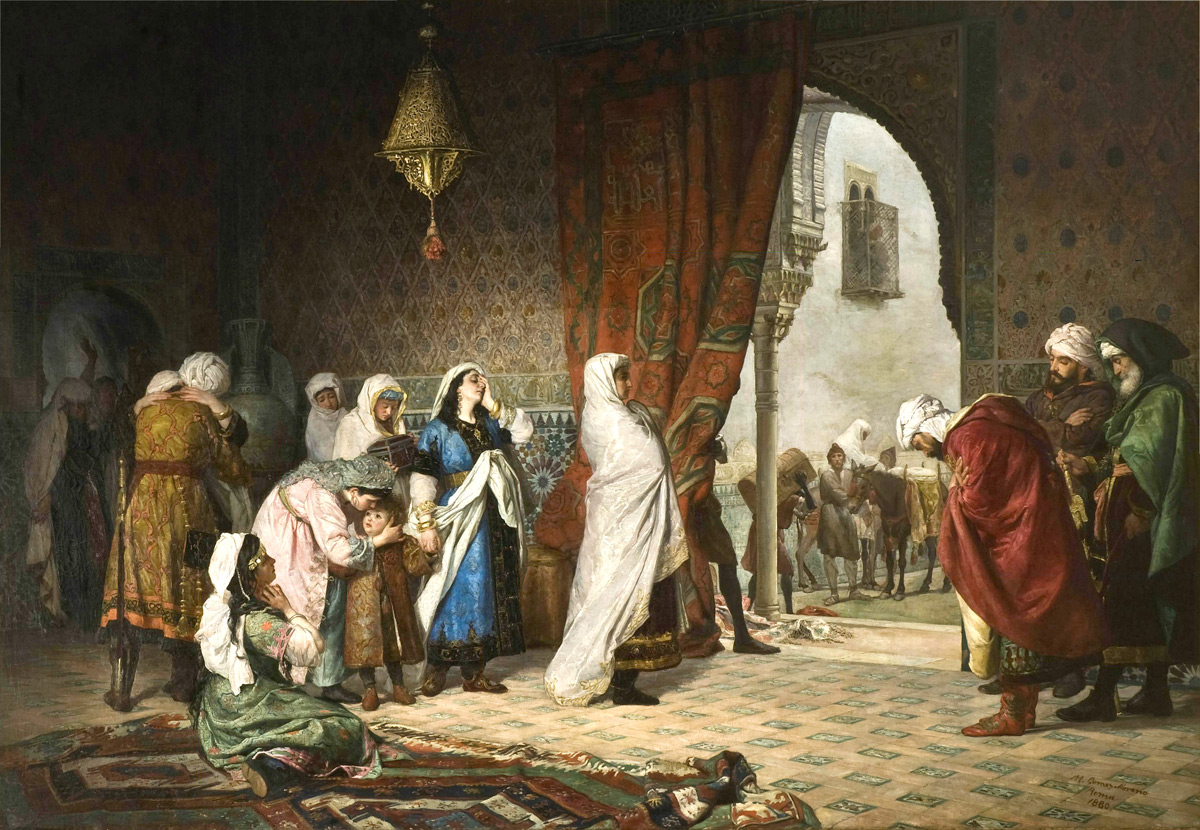1.2 “Romance de la pérdida de Alhama” – Anónimo
7 min read•june 18, 2024
Sitara H
Kashvi Panjolia
AP Spanish Literature 💃🏽
24 resourcesSee Units
The "Romance de la pérdida Alhama" is a poem of the form known as a romance. Given that most of the legends in the Iberian Peninsula were transmitted orally, there is no doubt that the fusion of music and poetry gave rise to a rich tradition of "romances" in medieval literature, including this notable work.
Summary of "Romance de la pérdida de Alhama"
The poem discusses the loss of Alhama—an important fort in the kingdom of Granada—by the Moors to the Christians. The poem opens with the Moorish king receiving news that the fort of Alhama has been conquered by Christians. Unable to cope with the news, the king burns the letters and kills the messenger (“las cartas echó en el fuego / y al mensajero matara"). The Muslim king’s people who hear the news are devastated. They are angry at him for letting the Christians take over the town, and they start questioning him about why the fort was compromised. The king wants to mount a resistance, and trades his mule for a horse to try and inspire his soldiers to fight ("descabalga de una mula / y en un caballo cabalga"). Even as the poem continues to build, the poetic voice presents the resistance as futile no matter their numbers (“uno a uno y dos a dos / juntado se ha gran batalla”).
Throughout the poem, the chorus — "¡Ay de mi Alhama!" — represents the voices of the despairing Muslims faced with the news. Even as the king tries to inspire his soldiers to fight, the chorus continues to remind the audience of the impact of the loss of Alhama.
Then, the king is confronted by an alfaquí, an Islamic advisor/elder, who announces that the Christians have already conquered the fort (“cristianos de braveza / ya nos han ganado Alhama”). The alfaquí also scolds the king for his role in the killing of the Abencerrajes, an important noble family that the royal family was at odds with), and for having accepted Christian converts to his court. In this way, the alfaquí states, the king has killed his own kinsmen while accepting strangers into his court, weakening the Moorish kingdom through his actions. The alfaquí then declares that the king deserves to lose his kingdom, and that the Moors deserve to lose Al-Andalus (the Muslim-ruled part of the Iberian peninsula).
Context of "Romance de la pérdida de Alhama"
Author Background
This poem is unique for not having an author—this is because the poem was spread to different audiences via oral tradition. Since many people in the Middle Ages couldn't read, this poem was recited orally, sometimes as a song. As a result, it is difficult to pinpoint its origins back to one person specifically.
Time and Place
🕰️ Time Period - Epoca Medieval/Siglo de Oro: This piece was written in 1482, around the start of Spain’s “Siglo de Oro”, or Golden Age. This was a time of political strength for Spain, starting right around the time of the Spanish Reconquista and Columbus’s successful voyage to the Americas. As a result, Spain’s global political and economic influence grew tenfold. As for the arts, this meant that underlying themes of nationalism and pride in Spanish traditions and culture could be found in many popular works from this time period.
📚 Historical: From the early 8th century to the expulsion of Jewish people from Spain in 1492 by the Alhambra Decree, all Spanish people lived in harmony. This period of time is referred to as “Convivencia”, and refers to the coexistence of Christian, Muslim and Jewish communities in Spain. As a result, cross-cultural interactions are also a common theme of many literary works from this time period.
Convivencia ended with the fall of Granada, as Christian control over Spain was solidified. Alhama was an important fort for the Moors, and once it fell their days were numbered. This poem tells the story of how the Moors lost control of the crucial fort.
Elements of Poetry
🔎 Objective/Purpose: The poem’s purpose was to inform the public about the capture of Alhama, the last Moorish fort, by the Catholics. During this time, most news, stories, etc. were transmitted orally because the ability to read and write was limited to a select few.
📜 Poetic Structure: This poem is a romance, which means it is characterized by assonant rhyme structure (rhyming vowels across alternating lines) and 8 syllables per line.
🗣️ Poetic Voice: Even though the plot talks about the loss of Alhama and the defeat of the Muslims in Spain, the narrator is Christian. This is evident from the bias found in the verse “cristianos de breveza”, as it is unlikely for a Muslim in Al-Andalus to have called their enemies brave.
Analyzing "Romance de la pérdida de Alhama"
Romance of the Middle Ages
The romance of the Middle Ages as a literary work has several characteristics:
- 8️⃣ It is octosyllabic, meaning that each verse has 8️⃣ syllables
- 🅰️🅰️ Romances have assonant rhyme on even verses
- 🎶 Often, they include a chorus, or a repeated verse that harkens back to the central idea
- ♾️ They have an unlimited number of verses
The poem is set in the last stage of Al-Ándalus, around the year 1490. Granada was the last Moorish kingdom remaining during the Spanish Reconquista, so the fall of Granada signified the end of the era of Convivencia and the time of the Moors in Spain. Each stanza highlights the inevitability of the Catholic kings conquering Alhama and the rest of Al-Andalus.

Battle of the Reconquista, from the margins of the Cántiga de Santa María. Image courtesy of Wikimedia.
Literary Devices
Be aware of the following literary devices used in this poem:
- This romance is octosyllabic and has an assonant rhyme scheme in even verses (e.g. “por la ciudad de Granada . . .“hasta la de Vivarrambla”).
- It includes a chorus (estribillo) — “¡Ay de mi Alhama!” — which highlights the devastating end of Al-Andalus, and the despair the Moors felt as the last kingdom fell to the Christians. 😔
- To preserve the number of syllables throughout the romance, the author uses sinalefa to reduce the number of syllables to in the verses that have more. The sinalefa combines vowel syllables into a single syllable when necessary. See the following examples:
- “y en un caballo cabalga” has 9 syllables (y/en/un/ca/ba/llo/ca/bal/ga). To protect the 8-syllable meter of the romance, sinalefa is used to combine the first two syllables in one (y-en/un/ca/ba/llo/ca/bal/ga)
- Sinalefa can also be used to combine two syllables even if the second begins with an h-. For example, the verse “juntado se ha gran batalla” includes 9 syllables (jun/ta/do/se/ha/gran/ba/ta/lla), but by combining syllables 4 and 5 (jun/ta/do/se-ha/gran/ba/ta/lla), the poetic voice maintains the eight-syllable meter.
- The author also uses hyperbaton (hipérbaton) several times to preserve the rhyme scheme of the poem. Hyperbaton changes the order of words within a verse so that it ends with the desired rhyming sound. For example, the author of the romance could have written “echó las cartas en el fuego / y matara al mensajero” in the second stanza, but given that the prior rhyming verse ended with an –a, the author shuffled words around so that the verse “y matara al mensajero” also ended with an –a , “y al mensajero matara”.
- This poem contains polifonía because it contains many different poetic voices, such as the narrator, the elderly Moor, and the alfaquí.
- Since many people in the Middle Ages couldn't read, this poem was recited orally, sometimes as a song. It demonstrates the oral tradition of Spain in this time period. 🗣
- The odd verses in the poem do not have a rhyme scheme, so this poem also contains blank verses (versos blancos).

"La salida de la familia de Boabdil de la Alhambra"—The Departure of Boabdil's Family from the Alhambra, Manuel Gómez-Moreno González (1834-1918). Image courtesy of Wikimedia.
Themes of "Romance de la pérdida de Alhama"
🤝 Sociedades en contacto / Societies in Contact
The poem is set against the backdrop of the final stages of the Spanish Reconquista, as Granada is one of the last parts of Spain to fall from Moorish control. The interactions between the Christians and the Moors are also evident in the alfaquí’s references to the Christian converts in the court of the Moorish king, and how his kingdom was likely weakened from the inside out leading up to the fall of the fort of Alhama.
⚔️ El Imperialismo / Imperialism
This poem shows the effects of the Spanish Reconquista on the Moors, although from the skewed perspective of a Christian narrator. The Moors were devastated at the loss of their kingdom of Granada to the Christians, while the Christians were likely overjoyed that they had completed their Reconquista.
This poem is one of 2 works that are covered in Unit 1: La epoca medieval and is set against the backdrop of the sociopolitical events of the time, namely the Spanish Reconquista. In this way, the poem uses its themes to inform its audience about the fall of Alhama.
Browse Study Guides By Unit
🏇Unit 1 – La época medieval
🛳Unit 2 – El siglo XVI
🖌Unit 3 – El siglo XVII
🎨Unit 4 – La literatura romántica, realista y naturalista
🤺Unit 5 – La Generación del 98 y el Modernismo
🎭Unit 6 – Teatro y poesía del siglo XX
🌎Unit 7 – El Boom latinoamericano
🗣Unit 8 – Escritores contemporáneos de Estados Unidos, y España

Fiveable
Resources
© 2025 Fiveable Inc. All rights reserved.